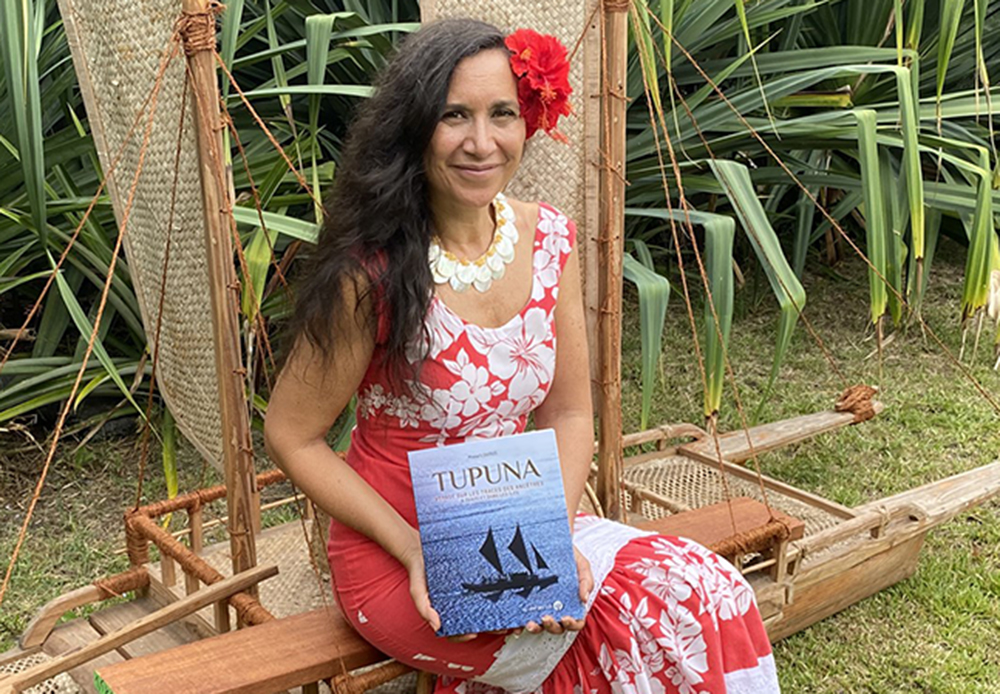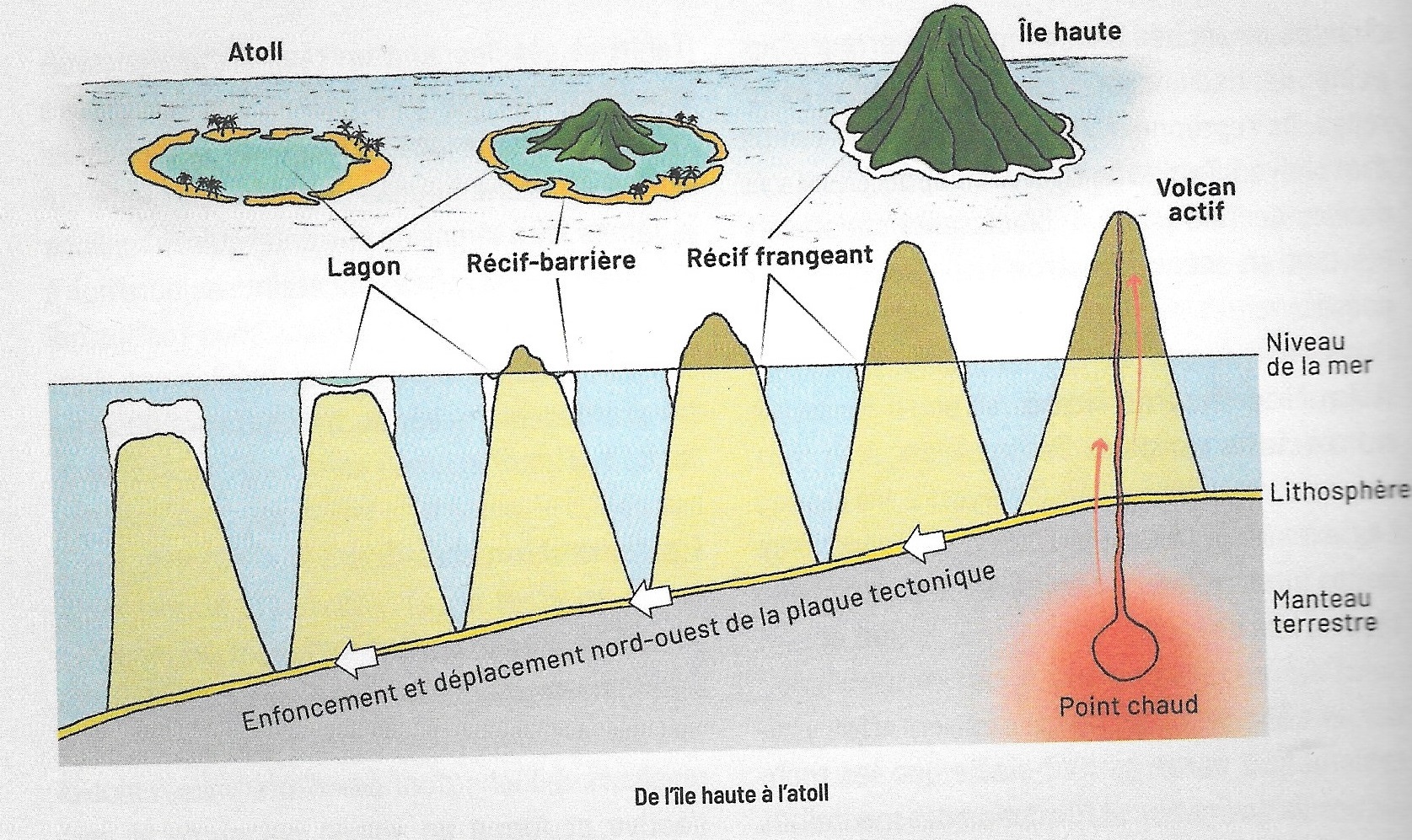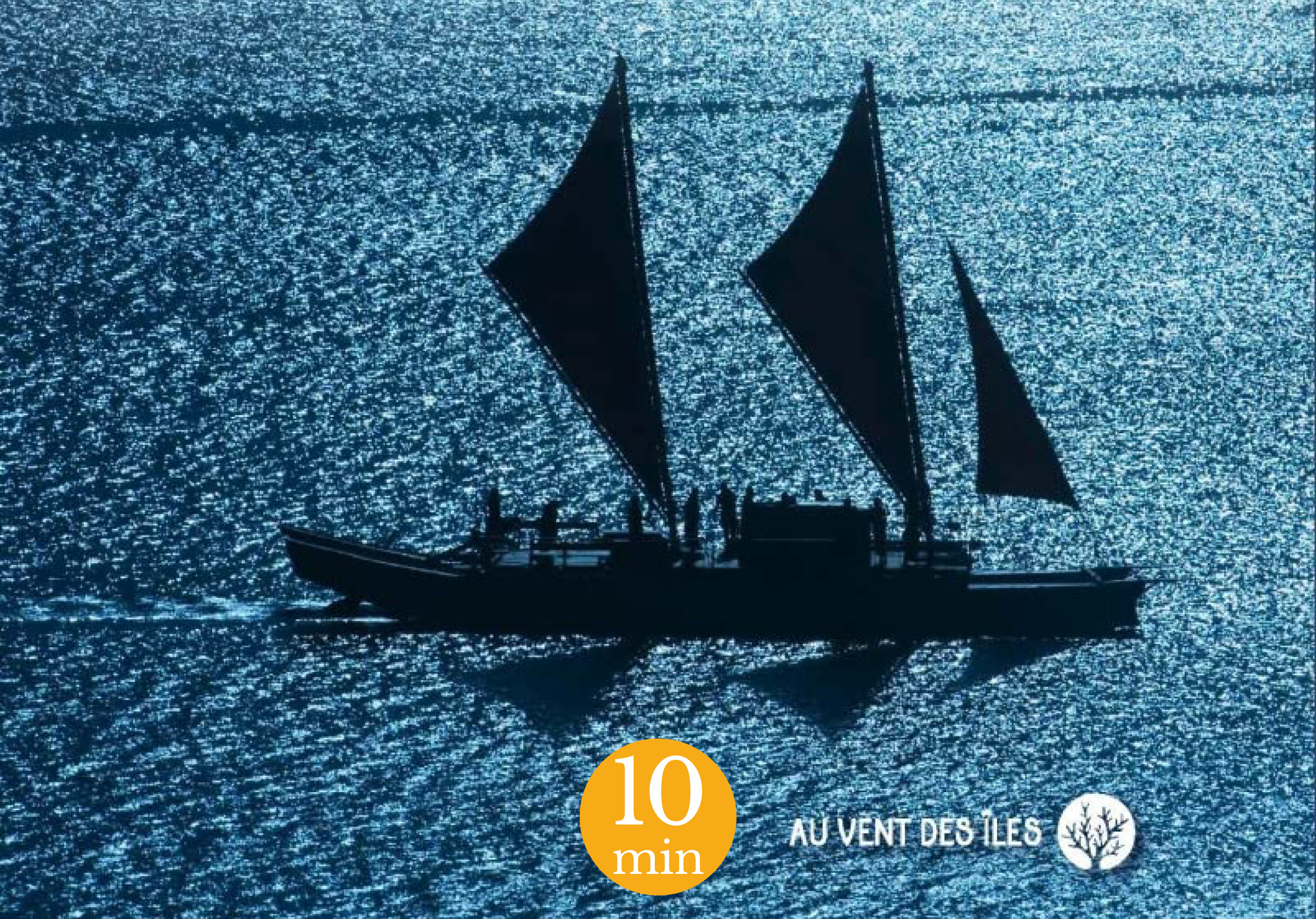"No man, however, can live normally if he is cut off from the roots of his past; this is no different of societies".1
This observation by José Garanger, an archaeologist and professor at the University of Paris I who orchestrated excavations in Polynesia with his students, could also be the leitmotiv of Moearii Darius' long project (more than ten years) of documenting and then writing the book Tupuna, Voyage sur les Traces des Ancêtres à Tahiti et dans les îles, to be published (Tupuna, Journey on the Tracks of the Ancestors in Tahiti and the Islands) in 2021 by Au vent des îles.
This book is, in a way, the view of a Polynesian woman of today on history, or rather on the stories of her people and her ancestors, as tupuna means "ancestor" in Tahitian. Moearii Darius is Polynesian through her mother, with multiple origins, including Tahitian ancestors, and French through her father. This multiculturality in a way announces her intention. Moearii's ancestors are Polynesian, French and part of her family is Chinese. In her account of French Polynesia (including the archipelagos of the Marquesas, the Gambiers, the Tuamotus, the Society and the Austral Islands), the idea is not to forget anyone, because they are all part of the history of these islands, some having a greater posterity in the texts than others. Moearii Darius works for the rediscovery and maintenance of the Polynesian heritage through her investment in traditional Tahitian dance, her commitment to the revival of ancestral navigation techniques, but also through her work in air transport and tourism.
Here, we do not provide you with a summary of the book, because it would be vain and not very useful to try to synthesize a 250 pages book whose subjects are so varied that we could not treat correctly any of them. The idea here is only to make you discover this manual of Polynesia, from ancient times to today, and its message of hope.

The author Moearri Darius and her book. Photograph published on the radiotefana website. © Radiotefana
The need to write following an observation
Moearii Darius notes at the beginning of her book the lack of sources on the history of the islands of French Polynesia. This is characterised by the absence of written sources from the indigenous populations, then living in an oral tradition, disrupted, like all the ancestral traditions of these islands by colonisation, Christianisation, Europeanisation, and the demographic crisis. We observe then a preeminence of European sources about the ancient societies of Polynesia, notably from travelers, missionaries and settlers, whose view, impregnated with their own culture, was biased, incomplete and often composed of many prejudices.
Through her book, the author seeks to recover the identity and memory of Polynesian ancestors, so that "we are no longer a people without memory"2, she says. She speaks of a "black veil of the past"3 placed over the country's history. A history which is not necessarily the one we imagine, a history which is not always accessible, often scattered in various sources. All the more so as the school curriculum is centred on the history of metropolitan France and other countries: the Polynesian past remains a mystery.
Tupuna is divided into six chapters. The first focuses on the formation of the Pacific islands and the origin of the Polynesian settlement through a detailed description of ancestral navigation techniques. The second seeks to discuss the various myths surrounding Pacific peoples, some of which are still very much alive, developed through the eyes of the first Western travelers. This is followed by a chapter on the organisation and ancient traditions of this 'lost civilisation', then comes the colonial period, the place held by the Church, the attraction of the city and the Europeanisation of lifestyles, the changes in traditions and the natural environment. The last two chapters, on which we will dwell later, are dedicated to the political and economic revival, as well as to the rebirth of Polynesian culture, and to the natural heritage of these islands.
A book with multiple formats
This book is protean, rich in information, and illustrated with archival images from the Museum of Tahiti and the Islands and the photographs of Jean-Bernard Carillet, author and photographer for Lonely Planet. The author's diagrams and chronologies are added to these iconographic elements, for greater clarity. This very educational and illustrated aspect is the same as that found in school books. And for good reason. The author explains this unique format: "I wrote this book with all the people who don't like to read in mind. She underlines the fact that the book itself is one thing, but that a lot of knowledge is still to be drawn from the knowledge of some people regarding oral traditions and craft techniques... A lot of work remains to be done, therefore.

Diagram illustrating the formation of atolls, made by O.Bichet, in the book "Tupuna" by Moearii Darius, 2021, p16. © O. Bichet/ M. Darius/ Au vent des îles
Yet the author's undertaking is already colossal. Readers will come across subjects as diverse as geology, botany, history, navigation techniques, politics, archaeology and anthropology, as well as linguistics. Moearii Darius uses clear, accessible terms, but never forgets to be very precise and scientific in what she says. Furthermore, the areas she is least familiar with are verified by specialists.
One can imagine the efforts made by Moearii Darius to juggle all these disciplines, their concepts, their vocabulary, and this work pays off. Each term is explained, a definition is given whenever the reader may need it, and the vernacular is used as much as possible. In an interview with Miriama Bono, director of the Museum of Tahiti and the Islands, for the podcast Tahitian Talk, Moearii Darius explains that she seeks first and foremost to give voice to indigenous sources and does not hesitate to put various interpretations of the same fact into dialogue. For example, diagrams on volcanic formations and the creation of islands dialogue with Polynesian myths on the same subject. History, as told by Moearii, is also the evolution of theories, the evolution of the view supported by archaeology and anthropology.
Mixing written and oral history
It is a book that presents itself as a history book written from several voices, those of the European travellers, their first approach accompanied by their first prejudices about the islands of French Polynesia, but also those of Polynesians. Moearii seeks to highlight their voices through oral tradition, but also their visions and perceptions of history. On the subject of the first contacts between Polynesians and European travelers, for example, she points to numerous misunderstandings, often leading to tragic consequences, and examines these from the point of view of both the islanders and the arrivals. For example, Samuel Wallis5, who arrived in Tahiti in 1767, when offered a bouquet of red and yellow feathers as a declaration of war, misunderstands the message and mistook it for an offering, leading to violent fights.This maro'ura, literally "red belt", is an object of memory, used by the communities to materialise the genealogy that CASOAR mentions here.
As a vector of memory and tradition, oral history is thus essential to shed new light on the course of these first encounters and to qualify the accounts of the first Europeans to arrive on these islands.
A “lost civilisation”
At the centre of the decline of the original peoples of the Pacific, the author emphasises the demographic crisis that hit the islands of French Polynesia throughout the 19th century. Thus, according to the figures she was able to gather, Moearii makes the sad observation that 'more than 80% of the populations perished from hitherto unknown diseases in the decades following the first contacts. No archipelago was spared".6 She points out that this demographic crisis was accompanied by a psychological crisis for the populations, but also by a forgetfulness of traditions, with the disappearance of an older generation, as the peoples turned to European religions promoted by the missionaries. The latter set up numerous rules, many of which condemned ancestral traditions as incompatible with Christianity. As Jack London wrote about Tahiti, "Death is everywhere"7 and it is not only due to diseases but also to alcohol and firearms, introduced by the Europeans.
The arrival and reception of the Chinese communities in the islands is also mentioned in the course of the book. While many peoples lived on these islands in the 19th and 20th centuries, the author emphasises the fact that there was little mixing and that people lived in communities. She therefore insists on the drama of the demographic and cultural crisis of the 19th century, but does not forget to mention the variety of populations living on the islands at that time.
A work born out of curiosity, conceived in nuance
Moearii Darius' curiosity has led her to constantly ask herself new questions in the course of her research, which is what makes this book so rich. She never takes for granted a story that has been told to her, she always seeks to deepen her research, to nuance the views and data, by highlighting the most recent discoveries, the points of disagreement between researchers, or the points on which we do not really have an answer.
For example, she mentions terms that are not appropriate to Polynesian cultures and history, so that readers can adapt their vocabulary later. This is the case, for example, with the terms 'Stone Age' or 'Bronze Age', which cannot be applied to peoples whose environment does not contain minerals in their natural state. The same is true of the term 'prehistoric', or the 'discovery' of the islands by Europeans. As she demonstrates throughout her book, the Pacific inhabitants had very vibrant and rich cultures before the arrival of the Europeans. It is therefore 'pre-European' time, not prehistoric, and Europeans did not 'discover' the islands because they were already inhabited.
A message of hope
The last two chapters of the book focus on a more contemporary period. The fifth chapter is dedicated to the political renewal and economic choices of Polynesia, while the last chapter focuses on the renaissance of culture and heritage.
Moearii Darius insists on the consequences and the polemics and stakes surrounding the creation in 1963 of a Pacific Experimental Centre, i.e. the nuclear tests that France carried out on the islands of Moruroa and Fangataufa in its arms race. She underlines the link between this CEP and the growing demands for independence at that time. She also shows the link between this Centre, the arrival of an administration from metropolitan France and military corps in the region, and the acceleration of the transition from a subsistence society to a consumer society, increasingly dependent on metropolitan France for administrative matters and the import of goods. Although Polynesia has many economic assets, from tourism and pearl oyster farming to air transport and export products, the country's economy is in fact highly dependent on international economic conditions. Tourism, for example, represents 17% of the GDP. One can imagine the disastrous consequences of a global pandemic on this economy. Moearii also raises the inequalities that characterise this territory. In 1988, for example, Polynesian households were under-represented in the higher intellectual categories (only 10%). In 2017, between 25% and 55% (depending on the criteria chosen) of the population of Tahiti and Moorea live below the poverty line.
However, following these observations, Moearii offers a hopeful look at the future of the islands, notably by evoking personalities who are reviving traditions through their research and commitments. For example, this is the case of Madeleine Moua, a dancer who, after much research, managed to rediscover the steps of certain traditional dances after more than a century of Tapu (a Polynesian word that entered the English language as "taboo", "forbidden"), particularly following the missionaries' prohibition of these performances, which were deemed contrary to Christian morality. She also focuses on Mā'ohi people, the young intellectual elite who, in the late 1960s, reacted to the identity crisis experienced by Polynesia. In his manifesto Ma'ohi ou l'identité bafouée, at the end of the 1970s, Turo a Raapoto expressed himself in these terms: "A whole people dies comfortably, without words, as in a silent film, because others make the effort to speak for them, in their name."8 Many actors were campaigning for the rehabilitation of Tahitian, which had been banned in schools and replaced by French. In 1980, this vernacular language became an official language alongside French.
We also owe this cultural renewal, this rediscovery of both tangible and intangible heritage, to researchers, archaeologists and ethnologists, who, through excavations and surveys, have brought forgotten sites and traditions to light. This is the case, for example, of the excavations orchestrated by José Garanger, an archaeologist, and his team since 1963. Mentioned by Garance Nyssen in a previous article, the marae of Taputapuatea, listed as a World Heritage Site by UNESCO since 2017, is one of the emblematic sites. Like a travel guide, the last chapter of the book is highly illustrated and reveals the rich heritage, both tangible and intangible, but also the natural Polynesian environment. Moearii insists in particular on the great variety of endemic species in the Pacific and on the need to preserve them, many of which are protected and threatened with extinction. With regard to intangible heritage, the author focuses on traditional dance and song, which are maintained and promoted by the Heiva i Tahiti festival. She also mentions the construction of large double dugout canoes, similar to those that allowed the first inhabitants to arrive on these islands and discover new ones, and the use of ancestral navigation techniques.

Photographs of three Polynesian cultural sites, taken by J.-B. Carillet, in "Tupuna" by Moearii Darius, 2021, p 225 © J.-B. Carillet / Moearii Darius / Au vent des îles
A natural and cultural heritage that is certainly in danger, but which it is up to everyone to preserve and perpetuate. Moearii ends her last chapter with the following words:
"Although Polynesian ancestral culture has been severely damaged by the whims of time and history, it continues to be open to others and to be shared. It is interesting to note that it is not only the domain of scholars, public and private organisations, but also of all those who hold knowledge and know-how within families. Each one can thus contribute his or her bit in order to braid the transmission of the cultures of Tahiti and the archipelagos.
There is therefore every reason to be hopeful."9
Whether you are a traveller, a history buff, a geopolitician, or a natural or cultural heritage enthusiast, this book is for everyone, and encourages you to continue the work of rediscovering Polynesian traditions.
Margaux Chataigner
Cover picture : Cover picture of the book Tupuna. Voyage sur les traces des ancêtres à Tahiti et dans les îles, 2021. Faafaite boat. © D. Hazama
1 José Garanger, archéologue, cited in CONTE, E., 2000. L’archéologie en Polynésie française. Esquisse d’un bilan critique. Tahiti, Au vent des îles, p. 18.
2 DARIUS, M., 2021. Tupuna. Voyage sur les traces des ancêtres à Tahiti et dans les îles. Tahiti, Au vent des îles, p. 4.
3 Moearii Darius interviewed in the podcast Tahitian Talk #28, « Moearii Darius – Voyage sur la trace des ancêtres », le 28 novembre 2021.
4 Ibid.
5 English explorer Samuel Wallis arrived in Tahiti on 17 June 1767. He was the first European to reach Tahiti.
6 DARIUS, M., 2021. Tupuna. Voyage sur les traces des ancêtres à Tahiti et dans les îles. Tahiti, Au vent des îles, p. 77.
7 Ibid., p. 162.
8 Turo a Rappoto cited by Moearii Darius. Ibid, p. 212.
9 Ibid., p. 247.
Bibliography :
- DARIUS, M., 2021. Tupuna. Voyage sur les traces des ancêtres à Tahiti et dans les îles, Au vent des îles.
- Podcast Tahitian Talk #28, « Moearii Darius – Voyage sur la trace des ancêtres », le 28 novembre 2021, https://podcast.ausha.co/tahitian-talk/28-moearii-darius-voyage-sur-la-trace-des-ancetres
